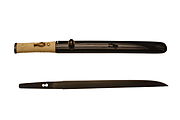Shintōgo Kunimitsu
- View a machine-translated version of the Japanese article.
- Machine translation, like DeepL or Google Translate, is a useful starting point for translations, but translators must revise errors as necessary and confirm that the translation is accurate, rather than simply copy-pasting machine-translated text into the English Wikipedia.
- Do not translate text that appears unreliable or low-quality. If possible, verify the text with references provided in the foreign-language article.
- You must provide copyright attribution in the edit summary accompanying your translation by providing an interlanguage link to the source of your translation. A model attribution edit summary is
Content in this edit is translated from the existing Japanese Wikipedia article at [[:ja:新藤五国光]]; see its history for attribution. - You may also add the template
{{Translated|ja|新藤五国光}}to the talk page. - For more guidance, see Wikipedia:Translation.
Shintōgo Kunimitsu (新藤五国光) was a Japanese swordsmith and was especially famous for making Tantō. He is the founder of the Soshu-den tradition. Usually he used suguha Hamon. The oldest date of his work is 1293. He was active during the Einin, Shōwa and Enkyō periods, generally acknowledged to be the teacher of master swordsmiths Masamune, Yukiimitsu and Norishige. This is due to various similarities in style and workmanship that indicate that Masamune was almost certainly his student.
An example of his work is known as 'Aizu Shintogo'. It is a tanto of 25.4 centimeters in length.
He had several sons, who likely crafted a number of swords under his name.
-
 Tantō blade on display at the Tokyo National Museum. Important Cultural Property.
Tantō blade on display at the Tokyo National Museum. Important Cultural Property. -
 Tantō blade and mounting, on display at the Sano Art Museum. Important Cultural Property.
Tantō blade and mounting, on display at the Sano Art Museum. Important Cultural Property. -
 Tantō blade and mounting, on display at the British Museum
Tantō blade and mounting, on display at the British Museum
References

- "Token Bijutsu" Nihon Koto Shi (History of Koto) by Dr. Honma Junji
Book: Japanese Swords by Nobuo Ogasawara (tenth edition, printed 1986)
- v
- t
- e












